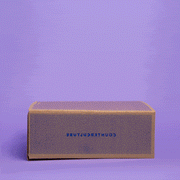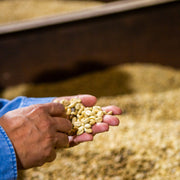Coffee roasting looms large in the imagination of most coffee enthusiasts and for good reason: Roasters transform unexceptional little seeds into the complex, diverse, and delicious “beans” that we grind, brew, and enjoy.
Even for experienced roasters, the transformation that coffee undergoes never stops being a source of fascination and excitement—especially if they are lucky enough to work with really great green coffee like we at Counter Culture Coffee do.

What Is Coffee Roasting?
Coffee roasting is the application of different types of heat to create chemical and physical changes in green coffee. It’s a simple process to describe but easy to mess up in practice. When roasting, you bring the coffee to a specific internal temperature, or level of development, through the careful application of heat and close observation. Heat not only caramelizes sugars and browns the coffee during the roasting process, but it also catalyzes a host of other chemical and physical changes, creating a product that is both familiar and surprising.

There are three basic types of heat transfer: conduction (contact heat) – like you get from a frying pan, convection (hot air) – like a blow dryer or popcorn popper, and radiance (radiation) – like the heat transmitted through space from our sun. The roasters at Counter Culture Coffee use all three types of heat conveyance in varying proportions. For example, our Probat roasters are heavier on conduction while our Loring roaster is heavier on convection.
How Do You Roast Coffee?
We adhere to a simple formula:
Great green coffee + the right amount of heat + the right amount of time = superbly roasted coffee.
There’s a variety of roasting equipment out there. Just as you can cook a steak in a pan, grill, broiler, or oven, roasting can range from cast-iron skillet to fully automated, stainless steel convection ovens. Also, there are many different styles and approaches to roasting. These include roasting darker, lighter, longer, or shorter, with more or less heat intensity along the way. Each one of these factors will impact the flavor of the coffee. Regardless of approach, roasters judge how “done” the beans are by an assortment of visual, smell, and temperature cues.

Our roasters use a combination of data and sensory testing to analyze roasts. All of our machines are run manually, meaning there is a human manipulating each batch and determining how the roast goes. Our machines offer precise information on how much heat is being introduced to the roasting process and how the coffee is reacting, but the dynamics in each machine vary tremendously. The sophistication of our equipment aid the precision and consistency of the roast, but the quality ultimately depends upon the experience of the roaster. They are experts at observing and interpreting the coffee’s cues and making necessary adjustments as the roast develops.
How Do You Differentiate Between Roast Levels?
We offer a broad range of roast profiles on our menu to suit different tastes. Lighter roast profiles tend to emphasize the unique characteristics of the coffee, while darker roasts tend to highlight the roast character.

Each coffee has a specific roast-level target that we evaluate using an Agtron light reflectometer. The Agtron bounces ultraviolet light off a sample of coffee and back to a sensor to analyze the color of ground or whole-bean coffee. It then gives the sample a number representing the degree of roast. The lower the number, the darker the roast. For example, our darkest roast, Forty-Six has an Agtron score of 52 while our single-origin roasts are 77-80.
You can find the roast level of every coffee we offer on our website. We also offer specific tasting notes for each coffee to more effectively help our customers find their ideal coffee. For instance, “dark chocolate, smoky, and full-bodied” for Forty-Six, or “citrus, floral, and silky” for Apollo. At the end of the day, our goal is to create balanced, interesting coffee, no matter the roast.






